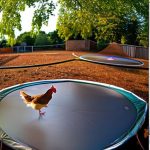Insulating a chicken coop is crucial for maintaining a warm environment during winter months. Several effective methods exist for insulating a coop, including adding insulation to walls, ceilings, and floors. Foam board insulation can be cut to fit walls and ceilings, while fiberglass insulation can be installed between wall studs.
Adding a layer of plastic sheeting over the insulation can further prevent drafts and retain heat. Proper sealing is essential for effective insulation. Inspect the coop for gaps or cracks where cold air might enter and warm air could escape.
Seal these areas with caulk or weather-stripping to maintain an airtight and warm environment. Windows and doors are common areas for heat loss, so insulating these openings is important. Covering windows with a layer of plastic can create an additional barrier against cold air.
Insulation is vital for chicken health during winter. An inadequately insulated coop can become cold and drafty, potentially leading to health issues for the birds. By implementing proper insulation techniques, chicken owners can ensure their flock remains warm and healthy throughout the colder months.
This proactive approach to coop maintenance is an important aspect of responsible chicken keeping.
Table of Contents
- 1 Provide a Heat Source
- 2 Use Deep Litter Method
- 3 Keep the Water from Freezing
- 4 Block Drafts
- 5 Add Extra Bedding
- 6 Monitor the Temperature
- 7 FAQs
- 7.1 What are some ways to keep chickens warm without power?
- 7.2 How can I insulate my chicken coop to keep it warm without power?
- 7.3 What is deep bedding and how can it help keep chickens warm?
- 7.4 What extra feed should I provide to keep my chickens warm without power?
- 7.5 Are there any heat sources I can use to keep my chickens warm without power?
Key Takeaways
- Insulating the coop is essential to keep the chickens warm during cold weather
- Providing a heat source such as a heat lamp or heated pad can help maintain a comfortable temperature
- Using the deep litter method can generate heat as the litter decomposes, keeping the coop warm
- Keeping the water from freezing is crucial for the chickens’ hydration and overall health
- Blocking drafts by sealing any gaps or cracks in the coop can prevent cold air from entering
- Adding extra bedding, such as straw or hay, can provide additional insulation and warmth
- Monitoring the temperature regularly to ensure it stays within a safe range for the chickens
Provide a Heat Source
Options for Heating a Chicken Coop
In addition to insulating the coop, providing a heat source is another important way to keep chickens warm during the winter. There are several options for heating a chicken coop, including heat lamps, radiant heaters, and heated pads. Heat lamps are a popular choice for providing warmth, as they can be easily hung from the ceiling of the coop and provide a steady source of heat. Radiant heaters are another option, as they can be mounted to the wall or ceiling and provide a gentle, radiant heat that warms the chickens and the surrounding air. Heated pads are also a good choice for providing warmth, as they can be placed on the floor of the coop and provide a cozy spot for chickens to rest.
Safety Precautions When Using a Heat Source
When using a heat source in the coop, it’s important to follow safety precautions to prevent fires and injuries. This includes ensuring that all electrical cords are in good condition and not at risk of being chewed by the chickens. It’s also important to keep the heat source at a safe distance from any flammable materials, such as bedding or nesting material. Additionally, it’s important to monitor the temperature in the coop regularly to ensure that it stays within a safe range.
The Importance of Providing a Heat Source
By providing a heat source in the coop, you can help to ensure that your chickens stay warm and comfortable throughout the winter. Providing a heat source in the chicken coop is essential for keeping the birds warm during the cold winter months. It’s important to choose a heat source that is safe and effective for your specific coop setup, and to follow safety precautions to prevent fires and injuries. By providing a heat source in the coop, you can help to ensure that your chickens stay warm and healthy throughout the winter.
Use Deep Litter Method

The deep litter method is a popular way to keep chickens warm during the winter while also managing waste in the coop. This method involves adding a thick layer of bedding, such as straw or wood shavings, to the floor of the coop and allowing it to build up over time. As the bedding decomposes, it generates heat, which helps to keep the coop warm.
Additionally, the deep litter method helps to absorb moisture and control odors in the coop, making it a practical solution for winter chicken care. To use the deep litter method effectively, it’s important to regularly turn and fluff the bedding to promote decomposition and airflow. Adding fresh bedding on top of the existing layer can also help to maintain warmth and cleanliness in the coop.
It’s important to monitor the condition of the bedding regularly and remove any wet or soiled areas to prevent mold and bacteria growth. By using the deep litter method in the chicken coop, you can help to keep your birds warm and comfortable throughout the winter while also managing waste effectively. The deep litter method is an effective way to keep chickens warm during the winter while also managing waste in the coop.
By adding a thick layer of bedding to the floor of the coop and allowing it to build up over time, you can create a warm and cozy environment for your birds. Regularly turning and fluffing the bedding, as well as adding fresh layers as needed, can help to maintain warmth and cleanliness in the coop. By using the deep litter method, you can help to ensure that your chickens stay warm and healthy throughout the winter.
Keep the Water from Freezing
Ensuring that chickens have access to unfrozen water is crucial for their health and well-being during the winter months. There are several ways to prevent water from freezing in the chicken coop, including using heated waterers, insulating water containers, and using heated bases. Heated waterers are a popular choice for preventing freezing, as they are designed to keep water at a constant temperature above freezing.
Insulating water containers with foam or blankets can also help to retain heat and prevent freezing. Additionally, using heated bases under water containers can help to keep water from freezing by providing a steady source of warmth. It’s important to regularly check water containers for ice buildup and ensure that chickens have access to clean, unfrozen water at all times.
This may require refilling water containers more frequently or using larger capacity waterers to ensure an adequate supply of water. By taking steps to prevent water from freezing in the chicken coop, you can help to ensure that your birds stay hydrated and healthy throughout the winter. Keeping water from freezing in the chicken coop is essential for ensuring that chickens stay hydrated and healthy during the winter months.
There are several ways to prevent water from freezing, including using heated waterers, insulating water containers, and using heated bases. It’s important to regularly check water containers for ice buildup and ensure that chickens have access to clean, unfrozen water at all times. By taking steps to prevent water from freezing in the coop, you can help to ensure that your birds stay hydrated and healthy throughout the winter.
Block Drafts
Blocking drafts in the chicken coop is an important step in keeping chickens warm during the winter months. Drafts can cause cold air to enter the coop and warm air to escape, making it difficult for chickens to stay warm. There are several ways to block drafts in the coop, including sealing gaps and cracks with caulk or weather-stripping, adding insulation to walls and windows, and using draft guards on doors.
It’s important to thoroughly inspect the coop for any areas where drafts could enter and take steps to seal them effectively. This may involve adding weather-stripping around doors and windows, filling gaps with caulk or foam insulation, or installing draft guards on doors. Additionally, ensuring that windows are well-insulated with plastic sheeting can help to further block drafts and retain heat in the coop.
By taking steps to block drafts in the chicken coop, you can help to create a warm and comfortable environment for your birds during the winter. Blocking drafts in the chicken coop is crucial for keeping chickens warm during the winter months. Drafts can cause cold air to enter the coop and warm air to escape, making it difficult for chickens to stay warm.
There are several ways to block drafts in the coop, including sealing gaps and cracks with caulk or weather-stripping, adding insulation to walls and windows, and using draft guards on doors. By taking steps to block drafts effectively, you can help to create a warm and comfortable environment for your birds during the winter.
Add Extra Bedding

Insulation and Heat Retention
Bedding such as straw or wood shavings provides excellent insulation against cold floors and helps to retain heat in the coop. By adding a thick layer of bedding on top of existing bedding, you can provide additional warmth for your chickens during cold weather.
Maintaining Cleanliness and Comfort
It’s essential to regularly check the bedding for moisture and replace any wet or soiled areas with fresh bedding. This helps to maintain cleanliness in the coop while also providing a warm and comfortable environment for your chickens. Additionally, adding extra bedding in nesting boxes can provide a cozy spot for hens to lay eggs during cold weather.
Ensuring a Warm and Cozy Environment
By adding extra bedding to the chicken coop, you can help ensure that your birds stay warm and comfortable throughout the winter. Regularly checking bedding for moisture and replacing any wet or soiled areas with fresh bedding helps to maintain cleanliness while providing a warm environment for your chickens.
Monitor the Temperature
Monitoring the temperature in the chicken coop is essential for ensuring that chickens stay warm and healthy during the winter months. It’s important to regularly check the temperature inside the coop using a thermometer and make adjustments as needed to maintain a comfortable temperature for chickens. The ideal temperature for most chicken breeds is between 50-70 degrees Fahrenheit.
If temperatures drop below this range, it may be necessary to provide additional heat sources or insulation in the coop. Conversely, if temperatures rise above this range, it may be necessary to provide ventilation or cooling measures in the coop. Regularly monitoring the temperature in the chicken coop allows you to make informed decisions about how best to keep your birds comfortable during cold weather.
Monitoring the temperature in the chicken coop is crucial for ensuring that chickens stay warm and healthy during the winter months. Regularly checking the temperature inside the coop using a thermometer allows you to make informed decisions about how best to keep your birds comfortable during cold weather. If temperatures drop below or rise above an ideal range, it may be necessary to provide additional heat sources or ventilation in order to maintain a comfortable temperature for chickens.
If you’re looking for more information on keeping chickens warm without power, you might be interested in this article on turning a shed into a chicken coop. This article provides helpful tips on converting a shed into a cozy and insulated space for your chickens to stay warm during the colder months.
FAQs
What are some ways to keep chickens warm without power?
Some ways to keep chickens warm without power include insulating the coop, using deep bedding, providing extra feed, and using heat sources such as heated waterers or heat lamps.
How can I insulate my chicken coop to keep it warm without power?
You can insulate your chicken coop by adding extra layers of bedding, sealing any drafts, and using materials such as straw bales or foam insulation to keep the heat in.
What is deep bedding and how can it help keep chickens warm?
Deep bedding involves adding layers of straw, wood shavings, or other bedding materials to the floor of the coop. This helps to insulate the coop and provide warmth for the chickens.
What extra feed should I provide to keep my chickens warm without power?
During cold weather, you can provide your chickens with extra feed such as cracked corn or high-protein treats to help them generate more body heat.
Are there any heat sources I can use to keep my chickens warm without power?
You can use heat sources such as heated waterers, heat lamps, or even hot water bottles wrapped in towels to provide warmth for your chickens during power outages.
Meet Walter, the feathered-friend fanatic of Florida! Nestled in the sunshine state, Walter struts through life with his feathered companions, clucking his way to happiness. With a coop that’s fancier than a five-star hotel, he’s the Don Juan of the chicken world. When he’s not teaching his hens to do the cha-cha, you’ll find him in a heated debate with his prized rooster, Sir Clucks-a-Lot. Walter’s poultry passion is no yolk; he’s the sunny-side-up guy you never knew you needed in your flock of friends!







